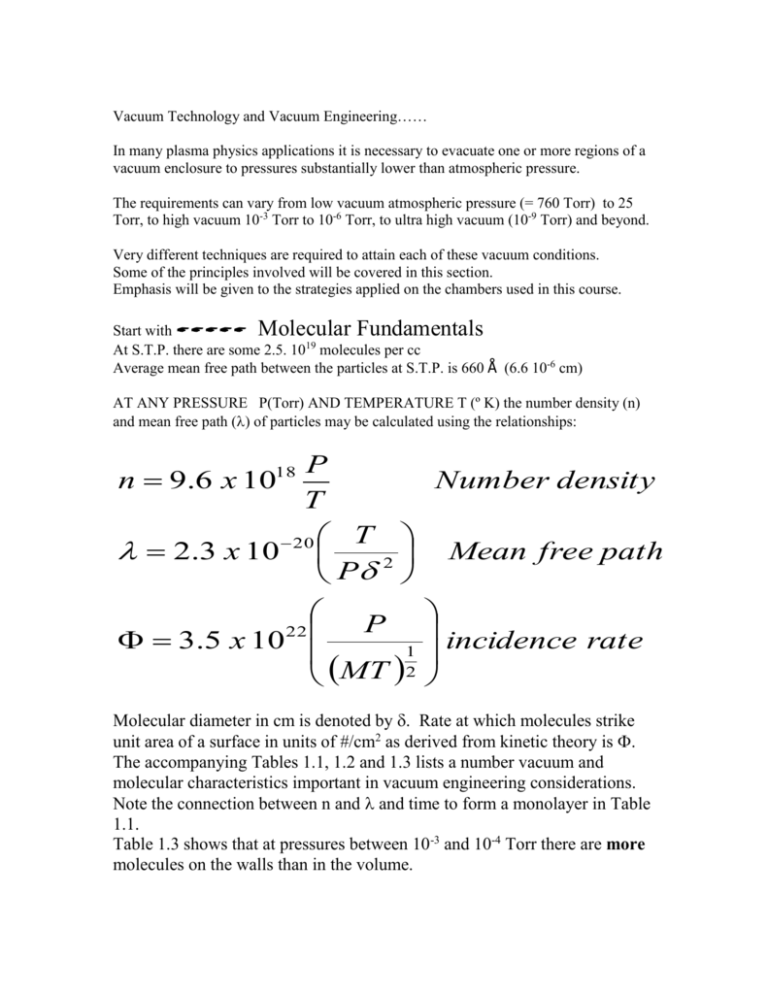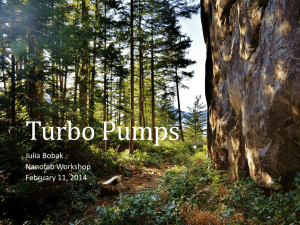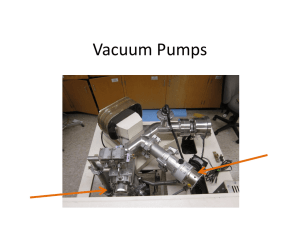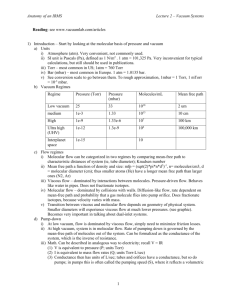Lab_4_VacuumPumps
advertisement

Vacuum Technology and Vacuum Engineering…… In many plasma physics applications it is necessary to evacuate one or more regions of a vacuum enclosure to pressures substantially lower than atmospheric pressure. The requirements can vary from low vacuum atmospheric pressure (= 760 Torr) to 25 Torr, to high vacuum 10-3 Torr to 10-6 Torr, to ultra high vacuum (10-9 Torr) and beyond. Very different techniques are required to attain each of these vacuum conditions. Some of the principles involved will be covered in this section. Emphasis will be given to the strategies applied on the chambers used in this course. Start with Molecular Fundamentals At S.T.P. there are some 2.5. 1019 molecules per cc Average mean free path between the particles at S.T.P. is 660 Å (6.6 10-6 cm) AT ANY PRESSURE P(Torr) AND TEMPERATURE T (º K) the number density (n) and mean free path () of particles may be calculated using the relationships: P Number density T T 2.3 x 10 20 Mean free path 2 P n 9.6 x 1018 P 3.5 x 10 1 MT 2 22 incidence rate Molecular diameter in cm is denoted by . Rate at which molecules strike unit area of a surface in units of #/cm2 as derived from kinetic theory is . The accompanying Tables 1.1, 1.2 and 1.3 lists a number vacuum and molecular characteristics important in vacuum engineering considerations. Note the connection between n and and time to form a monolayer in Table 1.1. Table 1.3 shows that at pressures between 10-3 and 10-4 Torr there are more molecules on the walls than in the volume. The mean free path concept is extremely important in vacuum engineering considerations. It defines the boundary between two types of gas flow. At high pressures when is much LESS than the dimensions of the container, the molecules are in a constant state of inter-collision, and gas behavior is dominated by the interactions between the particles. Such interactions result in viscous force and cause good communications throughout the gas. Called VISCOUS FLOW conditions. When becomes much LARGER than the dimensions of the container, the molecules collide then more frequently with the walls than with each other. The statistical motion of the independently moving molecules then governs gas behavior. Called MOLECULAR FLOW conditions. Between these extremes we have Slip Flow conditions. Vacuum pumps like vacuum gauges operate in limited pressure ranges. In general a pump that operates in the viscous flow domain will not operate in the molecular flow region and vice versa. We start with a consideration of commonly used terms GAS FLOW, CONDUCTANCE, PUMP THROUGHPUT, and SPEED For compressible gases the Volumetric flow rate indicates NOTHING about the QUANTITY of gas flowing unless both T and P are specified. One normally talks about “PUMPING SPEED”, S, (units are # liters/sec or volume per unit time) in place of volumetric flow. The product SP at the same point yields the throughput Q at that point. (units Torr liter/sec). To convert to mass flow rate use the relationship 1.7 10-4 Torr liter = 1 gram molecular weight. Conductance is defined as gas throughput Q per unit pressure drop Q/P (= F liter/sec). See chapter 3 for different geometries. MECHANICAL PUMPS-- see Chapter 10– Pressures of 10-2 to 10-4 Torr--- Viscous flow Used extensively for initial system exhaust and for backing to lower pressures other pumps that are incapable of operating directly to atmospheric pressure. Such pumps employ an oil sealed rotor that turns off center within a cylindrical stator. The interior of the pump is divided into two volumes by spring-loaded vanes attached to the rotor. Gas from the pump inlet enters one of these volumes and is compressed and forced through a one-way valve to the exhaust. Oil is introduced into the chamber to provide sealing of the sliding surface (vanes) and the stator. The thin film of oil is maintained by the oil reservoir on top. The gas pressure in the final stage of compression exceeds atmospheric pressure and in conjunction with the oil is swept out of the chamber through some form of check valve. Two stage versions employ two rotors. Note the improvement in base pressure attained. Pumps revolve at few hundred revolutions/minute. Usual capacity 10’s to 1000 cubic feet per minute. Ballast valves are employed to reduce the detrimental effects of water and other condensable vapors limiting the ultimate pressure that can be reached. Gas leaked into the compression chamber, raises the pressure and reduces the condensation. BIG problem with such pumps is back streaming. Recall at the lowest pressure they are actually operating in the molecular flow regime. OILLESS options Roots pumps handle large gas flows- inlet vanes TURBOMOLECULAR PUMPS—(high speed molecular bat). Functioning as a molecular turbine and operating in the molecular flow regime, this type of pump has almost completely replaced diffusion pumps in many plasma applications. These pumps cannot operate directly against atmospheric pressure and must be backed with a mechanical pump to lower the exhaust pressure at the exit into the molecular flow domain. The pump exploits momentum transfer from a series of high speed rotating blades (rotors) orientated to impart a significant component of velocity to the gas molecules in the direction of the pump exhaust. The rotors operate at speeds between 24, 000 to 60,000 rpm and the edge of the rotor is then moving at molecular speeds. Multiple blades distribute compression ratio. Provide roughly same pumping speed for all gases but the log of the compression ratio varies roughly with (molecular weight)½ Compression ratio of 107 for N2 would be only102 for H2. Compression ratio of 107 for N2 is for an exhaust pressure of 0.1 Torr. Increase pressure to 1 Torr Ratio becomes only 10. . Big advantage is that it provides for an oil free environment. Cost and maintenance must be factored into adoption considerations. High rotation speeds and close tolerances demand careful mounting. Small particles can create enormous damage to such pumps and may dictate pump mounting. Bringing chamber up to atmospheric pressure must be done with care. Motor and bearings are the critical elements of any turbo pump. Motor drive and control electronics are a significant fraction of the total cost of the pump. Active electronic control is required to maintain rotor speed over a wide range of loads and in order to protect the pump if overload occurs. Bearings can be grease packed and water cooled, lubricated with oil, air or magnetic field supported. Cryogenic Pumping. At sufficiently Low Temperatures cryocondensation, cryoabsorption, and crotrapping can be exploited for pumping. Cryocondensation requires that the pumping surface temperature be low enough to condense the vapor. CRYO PUMP. Any surface will act as a pump for a gas that condenses in contact with the surface. Cryopumps rely on this and use a closed-cycle helium refrigerator to cool the active surfaces. Their working temperatures are below 20 ºK . Usually such pumps have two stages of pumping. Stage 1 is usually a metal surface maintained between 30 to 100 ºK. This sector traps water vapor, carbon dioxide, and the major components of the air. Stage 2 operates between 10 and 20 ºK and is coated with a cryoabsorbant material such as charcoal to pump neon, hydrogen and helium. These pumps are very effective in pumping condensable gases but their performance with helium is critically dependant on the history and quality of the charcoal. In practice these pumps are used to keep a chamber at low pressure—they will not handle gas loads. Sorption Pumps are closed pumps that rely on cooled surfaces of materials like Zeolite or activated charcoal to pump chambers into the 10-3 Torr range. There are non refrigerated cooled pumps. DIFFUSION PUMPS Use a stream of high velocity vapor as the driving force. Generally the pump is operated in the molecular flow region and is capable of obtaining a maximum pumping speed at inlet pressures lower than 10–4 Torr. A stream of vapor at supersonic velocities comes out The basic components are the boiler (bottom), of the jet in the molecular flow region. The vapor stream imparts a forward (downward) component of velocity to the gas molecules to be pumped , and they are carried along toward the roughing pump. The vapor stream is recovered by condensing upon collisions with the cooled walls of the pinup. When two or three jets are used in series the pumps are ca11ed fractionating, Working fluids include distilled mineral oils, synthetic oils. Disadvantages include oil breakdown also oil gets pumped away. the jet assembly ( 1, 2, 3 in (a)), the casing and the working fluid.








